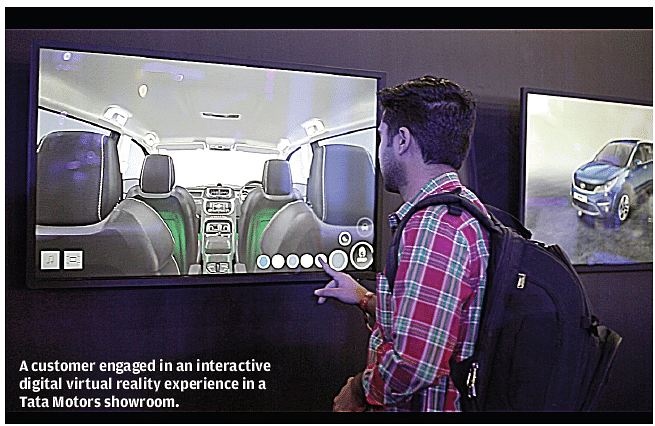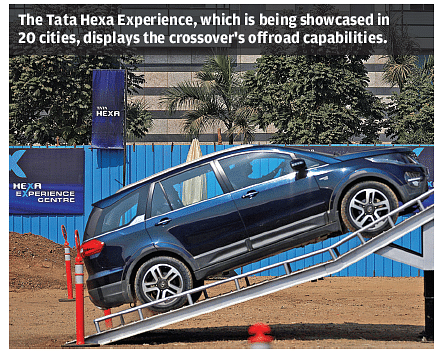‘The day is not far off when we will have fully digital showrooms.’
Customers have their first understanding of car online, while some of them do a search online and understand the product before they walk into a showroom.
Tata Motors' marketing head – Passenger Vehicle Business Unit reveals how new-age marketing, digital media strategies and methodologies are giving momentum to the company’s new models like the Tiago, Tigor and Hexa. An interview by Nilesh Wadhwa.
The Tiago hatchback has received a good market response. What are the key reasons that helped it click with buyers in India?
Since its launch 15 months ago, the Tiago is still on a growth path. During the April-June 2017 period, when the A2 segment grew around 10 percent, the Tiago saw 32 percent growth.
Our surveys had revealed that the consumer wanted better design (interior and exterior), more features (connectivity, infotainment), better mileage and reduced cost of ownership. We offered good design, plenty of convenience and infotainment features and paid great attention to the smallest of things that matter to a consumer. The Tiago offers around 19 utility places while the Tigor has twenty-four. Customers’ demands are not complex, they just need to be heard.
Did you employ any new marketing strategy for selling the Tiago?
Apart from the association with Lionel Messi, which was more on above-the-line marketing, we focused on the ground level. At the car’s launch, Augmented Reality (AR) glasses were given to customers to have a virtual attraction with the Tiago. We did not stop there. We believe that customers don’t just need a unidirectional advertisement (TV commercial or print advertisement). A more interactive or experiential experience is what we are driving towards and digital greatly helps.
We did the Hexa Experience across five towns where customers could touch and feel the product; currently, we are expanding it to 20 towns across the country.
Is marketing shifting towards more of digital and less of traditional media?
It is up to us how we define digital; for us, digital and experiential go hand-in-hand. For me, digital should enable the customer to experience the product in a different way. Secondly, digital enables a two-way communication. Our presence on social media helps us to speak to our consumer rather than just one-way communication on traditional media.

Social media can be a double-edged sword with both negative and positive feedback. How do you counter the negativity?
Social media has democratised communication, it has enabled everyone to be heard and have a dialogue across the board. It has positives and negatives, we at Tata Motors believe it is a positive. We are of the mindset that as a growing company every bit of feedback and criticism is going to help us, it is a key part of our customer learning experience.
The Tiago was part of this experience, it would not be possible without the social learning which is a key element of our strategy. We have a setup that constantly provides us about what the digital universe is talking about Tata Motors – each product, each feature. At the end of the day, I get a report of how many people are talking about us, how many complaints are received, how many were resolved.
Nowadays, if people have any issue they don’t call – they tweet about it or post it on Facebook. Our social listening cell continuously gives feedback – marketing, aftersales, sales – about customer complaints, product improvement and that helps us.
There are some situations where we are not able to respond. We will have to live with that but the pain of that small section of customers whose feedback is more than worth the kind of satisfaction with which we are able to help. Social listening gives me a good idea whether we are going in the right direction, if we are taking care of our customers before it is too late.
Are you using social media for marketing your new products?
We use social media for marketing our products as well. We have a very strong presence on Facebook, Twitter and Instagram but we are slowly moving away from the aggressive in-your-face kind of marketing on social media to more of a subtle presence. We use social media to remain in the customer’s consideration set, and not thrust our products in their face – irrespective of whether he wants it or not. If the customer wants to buy a car, relevant information can be shown. In digital, it is easier to track if a customer wants to buy a car or not.

What are the key changes in your marketing strategies?
Two years ago, 60-70 percent of our sales were to commercial customers. Last month, over 80 percent of sales were to personal buyers. There has been a huge shift in the past 24 months; earlier we were selling to commercial aggregators but today we are selling to individuals.
In today’s changed marketing times, we are forced to speak a completely different language in a complete different medium. At present, a lot of customers who visit our showrooms are largely working professionals, bankers and service-class people. A number of first-time buyers are looking to buy a Tata Motors product and hence the tonality of communication has to change.
We are focusing much more on our DNA now – design, connectivity and then total cost of ownership (TCO). A few years ago, we were focused only on TCO. Today, TCO comes third for the customer and we have aligned ourselves more around design and connectivity that modern customers look for. Also, we are no longer spread out on the digital platform. Earlier, we had around 40 digital handles on Twitter and Facebook. Now we have consolidated and streamlined them.
Customers are much more informed now and exactly know what they want to buy when they walk in to a showroom. How do you manage to get this customer to choose your product?
When we advertise, we get more customers visiting our website than walk-ins to a showroom. It has become a huge challenge for us to get customers to walk into our showrooms – people want to avoid the traffic, rain, weather and they'd rather do it digitally. So we try to give them a showroom kind of experience online. For instance, we came with a Hexa App that gave a virtual 360deg view and test drive of the SUV, with all features, and had an online product demonstration on our website. The only time a customer needed to visit the showroom would be to collect the car.
While we are moving in that direction, the Indian consumer prefers to see a new car in the showroom rather than seeing it on road, that is a challenge. Eighty percent of customers have their first understanding of car online, while 90 percent of them do a search online and understand the product before they walk into a showroom. Eighty percent of the customers, when visiting the showroom, are comparing prices. Fortunately, price does not deviate much between dealerships and this challenges the role of a salesperson. No longer do customers want a salesperson to explain details about the car; they are already aware, having researched beforehand. The salesman is there to do the commercials, but the entire explanation might happen digitally.
Is this scenario prevalent throughout the country (rural, urban markets) or is there any difference?
It’s definitely more in urban India but growing rapidly fast in Tier 2 and Tier 3 cities. The rate of adaptation is much faster in the rural parts. In fact, in some cases, we feel the rural customer does more research than his urban counterpart; he wants to double-check the product because he probably buys a car once in six years as compared to urban areas, where the buying frequency is once in three years.

Will brick-and-mortar showrooms be replaced with smaller units, given the growing digital penetration?
It is a possibility. The size of showrooms is already decreasing and this has already happened in two-wheelers. We are seeing a similar trend in car showrooms as well. A few relevant cars are available for display, but others are just available for test drives outside the showroom. In terms of adoption of technology to manage AR demo on display, currently we don’t have the necessary technology. On one hand, we have VR, AR and polar lens but none of them have reached the stage where it is easily executable, giving the customer the right level of experience. If you want to give a great experience, the costs are too high, but like everything the costs will come down, the technology will improve and the day is not far off where we will have fully digital showrooms.
How much do online PV sales contribute to overall Tata Motors numbers?
Online sales are at a nascent stage but clearly in between the one-year period when we launched the Tiago, Hexa and Tigor, we have seen a significant increase in the number of people who book online albeit in percentage terms, it is very low. Probably, because there is no additional benefit for a customer to book online and buyers in India are more comfortable bargaining and having a face-to-face with the dealer for trying to get additional benefits that are not possible online.
I feel if we are able to provide customers some advantage for buying online, this may change. With the Tigor, we saw around 15 percent of bookings online in the first month but now it has tapered down to around 1 percent because the initial adopters know that there is no additional benefit of booking online and they just want to book a car, but the potential is there.
RELATED ARTICLES
India: A Bastion Of Stability for Schaeffler
German autoparts maker Schaeffler’s CEO, Klaus Rosenfeld, describes India’s role in the company’s €24-25 billion empire....
'No Question of Us Being Late' - Suzuki India on e-2Wheeler Market
Suzuki Motorcycle India believes its EV entry is timely as the market is now mature enough to grow off genuine demand ra...
'India Can Become a Major Pillar for Us' - Marquardt Group
Björn Twiehaus, CEO of Marquardt Group, and Vishal Narvekar, the company's India GM, share their outlook on the Indian m...





 01 Aug 2017
01 Aug 2017
 2193 Views
2193 Views





 Ketan Thakkar
Ketan Thakkar


 Angitha Suresh
Angitha Suresh

 Darshan Nakhwa
Darshan Nakhwa

